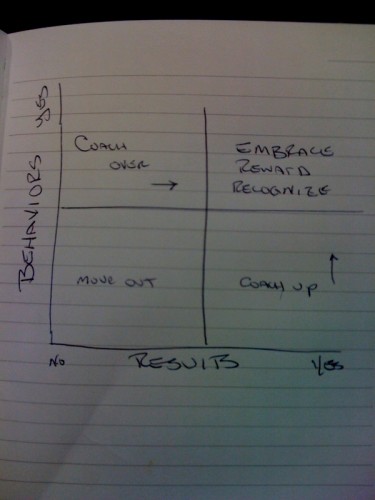I’ve only had to let go a few sales people in my day. Considering I’ve managed 100’s of sales people and sales leaders throughout my career I feel quite lucky. I chalk it up to hiring good people, coaching and as I said, luck. Letting someone go, regardless of the fact they aren’t a good fit or aren’t performing is a bad thing. It is never good if you get to a place where someone isn’t working out. When you have to fire someone for performance issues it represents a failure on everyones part. Theirs, the companies and mine.
Determining when you’ve reached that point is hard. It can be emotional and stressful.
To limit the stress and emotional impact I do two things, one is I coach. I talked about this in yesterdays post. Coaching doesn’t allow a problem to pop up. Coaching gives you visibility into whether or not a person is in trouble or struggling long before the big problems arise. Being able to see this early limits the fallout of surprises. It surfaces problems long before they can get too big. Coaching employees on a regular basis is the most important thing you can do to limit the impact of poor performance.
The bigger problem and more difficult challenge is to know WHEN it’s time. I am a big fan of the behaviors, results, matrix. It is one of most accurate and effective tools to determine when it’s time to part ways. Combined with coaching, it is almost bullet-proof.

Conventional wisdom says, if a sales person isn’t making their number, hit the streets. I don’t agree with that. There is more in determining whether you’ve got the right people than just results. I’ve never agreed with the old school sales approach of two quarters and your out, especially in complex selling environments. There may be some high-pressure, low complexity sales environments where a person not making their number after 6 months is doing something wrong and needs to go, but these are anomalies. In most cases there is more to determining whether someone should be fired than just results. You have to measure their behaviors too.
I want to know what someone is doing. Are they doing all the right things? Are they getting in front of the right people. Have they developed a strong plan. Do they know the industry, the customers strategic initiatives, their buyers objectives etc? Is the person exhibiting the behaviors the company values? I want to know this because if they are doing all the right things they will get there.
For me, I break it down like this, if they aren’t demonstrating the right behaviors and aren’t getting the results, they are out. I’ve only had this situation a couple of times. It’s an easy one. Don’t waste time with people who are in this quadrant. Get them out as fast as possible.
The people who demonstrate the behaviors but not the results, I work with. I look for measurable growth. I work closely with them. I expect them to be coachable and we work a plan. As long as they continue to demonstrate the behaviors and make continual progress, I stay with them. Not everyone agrees with me on this, but I found it works well. These people can be some of the most valuable team members. They have a tendency to bring positive energy, promote the cultural norms, provide informal leadership etc. Although the results aren’t coming as fast as I’d like they are bringing value to the team.
I don’t think I need to address the people who demonstrate both, treat them like gold and get out of their way.
It’s the sales person who is getting the results but isn’t demonstrating the behaviors that is the hardest. They are making their numbers, in some cases they are killing it, but they are a pain in the ass. The don’t demonstrate the cultural norms. They rub other team members wrong. They suck at following even the most unobtrusive processes. They leave a wake in their path. Despite their revenue value, I don’t have a long rope for folks in this quadrant. I coach them up or get them out. If they aren’t coachable, I cut them loose right away. Yes they are making their numbers, but there is a cost to it. I’ve found this cost is usually higher in the long run than their loss and replacement with someone who does both.
To summarize, because this post is getting long. If they demonstrate the behaviors and are getting the results, treat em like gold, and get them around the rest of the team. If they demonstrate behaviors but not the results; give them some rope, coach them and look for consistent, incremental improvement. They will get there. If they are getting the results, but aren’t demonstrating the behaviors, give them a short rope, coach and get them doing both as soon as possible or cut em lose. Don’t wast too much time. The longer they are in the organization and not embracing the cultural behaviors the longer they can undermine any value their revenue creates. If they aren’t doing either, get them out now. They won’t make it.
This methodology has served me well. Despite old school lore, it’s not just about the numbers when it comes to sales people. It’s more complicated than that.
Related articles by Zemanta
- How Do We Find The Time To Coach Our Sales People? (customerthink.com)
- 1-Minute Mastery: How to Rate a Winning Sales Manager (marketingpr.suite101.com)
- When the Sales Goals Change but the Behavior and Results Don’t (customerthink.com)


